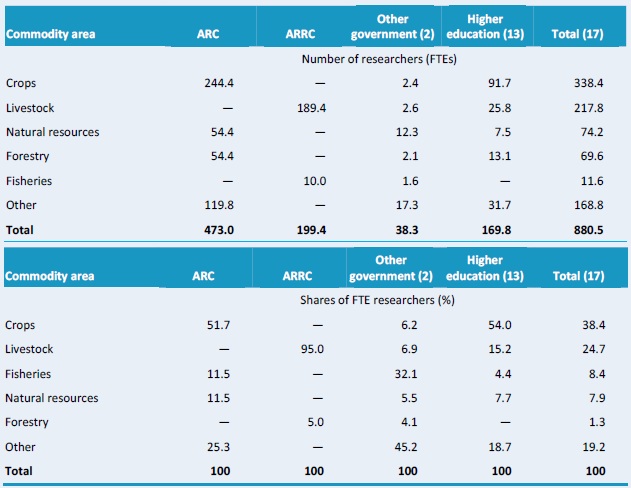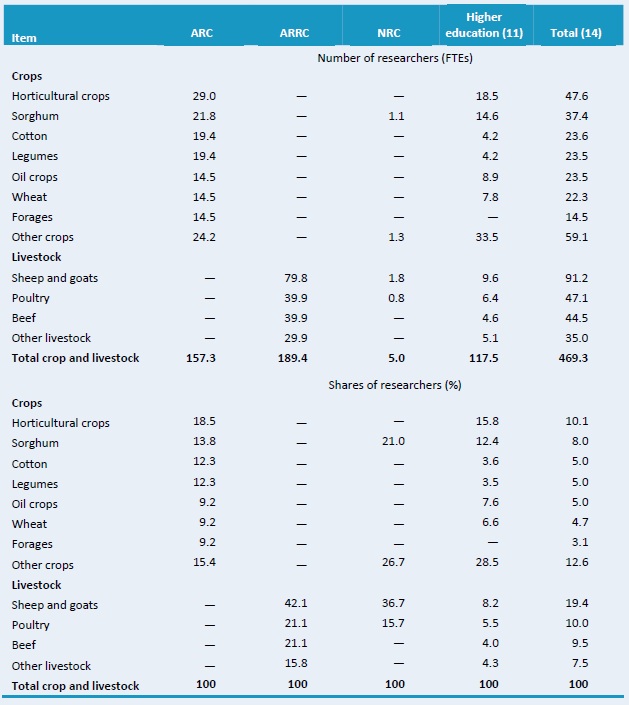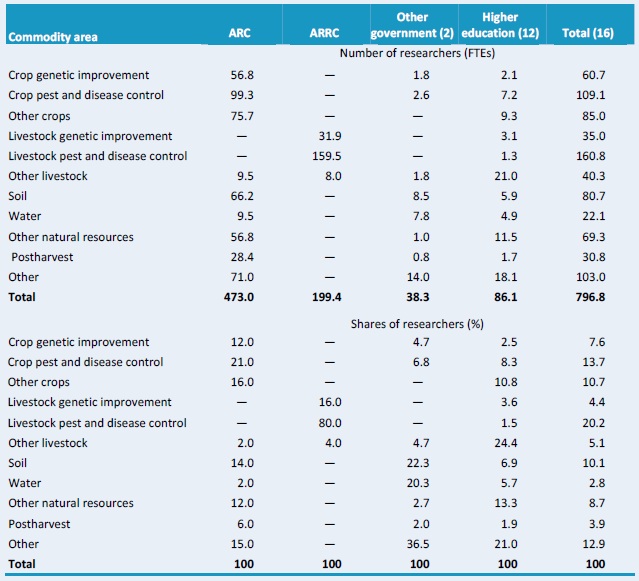The ASTI Data in Focus series provides additional background data in support of the 2010 Country Note on Sudan (asti.cgiar.org/pdf/Sudan-Note.pdf) prepared by the Agricultural Science and Technology Indicators (ASTI) initiative and the Agricultural Research Corporation (ARC). Based on data collected by ASTI and ARC, these two outputs review major investment and capacity trends in Sudanese public agricultural research and development (R&D) since 1971, providing important updates on agricultural R&D trends prepared by ASTI and ARC in 2002 - 03.
D. Research Allocation across Commodities and Themes
This section provides detailed quantitative information on Sudanese public agricultural research allocation in 2008. Supplementary sections present detailed data on long-term trends (Section A), financial resources (Section B), and human resources (Section C). Further supporting information provides macroeconomic trends, a list of agencies included in the study, data sources and estimation procedures, and ASTI's methodology.
Table D1–Research focus by major commodity area, 2008
This table presents the number of researchers by major commodity area, in both absolute and relative terms. The focus of agricultural research in Sudan is predominantly crops. In 2008, 338 of a sample of 880 full-time equivalent (FTE) researchers focused on crop research. Of the remaining researchers, 218 FTEs focused on livestock, 74 FTEs focused on natural resources, 70 FTEs focused on forestry, 12 FTEs focused on fisheries, and 169 FTEs focused on other commodity areas.

Source: Calculated by authors from ASTI - ARC 2010.
Notes: Figures in parentheses indicate the number of agencies in each category. Eighteen higher education agencies were excluded from the sample because of data unavailability.
Figure D1–Research focus by major commodity area, 2008
This figure presents the allocation of FTE researchers across the different commodity areas (see also Table D1). In 2008, 38 percent of Sudan's agricultural researchers were involved in crop research, livestock research accounted for 25 percent, and forestry and natural resources research for 8 percent each. The remaining researchers concentrated on postharvest, socioeconomic, fisheries, and water and irrigation research, or other matters. ARC and the higher education agencies primarily focused on crop research, while ARRC focuses almost entirely on livestock research, with a small percentage on fisheries. Of the other government agencies, HRS focuses on natural resources, while NCR is highly diversified in its research areas.

Source: Calculated by authors from ASTI - ARC 2010.
Notes: Figures in parentheses indicate the number of agencies in each category. Eighteen higher education agencies were excluded from the sample because of data unavailability.
Table D2–Focus of crop and livestock research by major item, 2008
Horticultural crops are the most researched crops in Sudan accounting for 10 percent of the country's total crop and livestock research. Sorghum accounted for 8 percent and cotton, legumes, oil crops, and wheat for 5 percent each. The country's livestock researchers concentrated primarily on sheep and goats (20 percent), poultry (10 percent), and beef (10 percent).

Source: Calculated by authors from ASTI - ARC 2010.
Notes: Figures in parentheses indicate the number of agencies in each category. Eighteen higher education agencies were excluded from the sample because of data unavailability. In addition, one government agency and two higher education agencies conducted neither crop nor livestock research.
Table D3–Focus of crop and livestock research by major theme, 2008
This table shows FTE researchers by thematic area in absolute and relative terms. In 2008, crop genetic improvement accounted for 8 percent of total FTE researcher time, whereas 14 percent of researchers focused on crop pest and disease control. Four percent of researchers focused on livestock genetic improvement, while 20 percent focused on livestock pest and disease control. Natural resources were also a major theme. The focus of the remaining researchers included farming systems, agricultural engineering, food safety, socioeconomics, capacity training, and postharvest issues.

Source: Calculated by authors from ASTI - ARC 2010.
Notes: Figures in parentheses indicate the number of agencies in each category. Nineteen higher education agencies were excluded from the sample because of data unavailability.
Copyright (C) 2011 International Food Policy Research Institute and Agricultural Research Corporation. Sections of this Data in Focus issue may be reproduced without the express permission of, but with acknowledgement to, IFPRI and ARC. This series has been prepared as an output for the ASTI initiative and has not been peer reviewed. Any opinions stated herein are those of ASTI and do not necessarily reflect the policies and opinions of IFPRI or ARC.
